Summary of Project:
In short, Hello Hermi features a ghoulish creature who waves to users with the intended purpose of sending the message to his audience (children) they should approach the house because they are welcoming trick-or-treaters. When people are far away (greater than 300 cm) Hermi will be waving long, slow waves and have glowing green eyes to send the message of invitation to children. As they get closer, approximately 300-150 cms, his wave will get a little slower and his eyes will turn red signaling for the children to stop and ask for candy. If they happen to keep advancing and get too close to Hermi (less than 150 cm) his eyes will flaw red and green and his arm movements will be really short and curt.
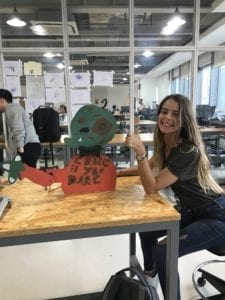
Introduction:
I really enjoyed our first group project. As someone with a background in robotics and working on collaborative teams, it was refreshing to be able to work on a team with a goal of creating a product useful for everyday life. After doing initial research into “what is interactivity,” I have come to the conclusion that interactivity is the process of an input creating an output different from what was input. An interaction is not simply a movement, but rather a change of variables which results in a totally different outcome from what it started as. In my group project, our concept was basically a series of algorithms which used the data taken from your day such as your body temperature, step count, and speed to create a painting that represented your day. I think that the foundation I gained in our original group project left me with some inspiration for our midterm project; I wanted to be able to create something that not only could be used in everyday life, but something that left people with a smile on their face.
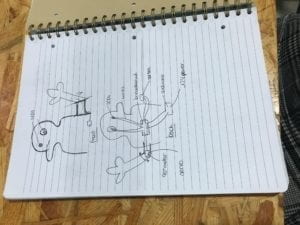
The inspiration for our midterm project definitely came from the Halloween season. When I was originally looking at the rubric, I was intrigued when I saw the additional option of “entertainment,” Normally when my mind is focused on a project with limited boundaries such as this one, I feel inspired to create something that will save the world. In this case, however, I felt inspired to create something entertaining since this is not normally the path I would take.
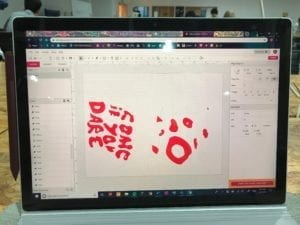
Concept and Design:
We began to toy with the idea of a ghost, or skeleton, or some sort of monster-like creature. Because of both my and my partner’s, limited realistic artistic ability, we decided to stay away from anything too scary due to the fact we might not be able to pull off something realistically scary. When we began doodling, I was trying to come up with something original. I did not want to look at any other doodles of cartoonized beasts and ghouls. Without copying it, but with the relative image in my mind, I fear that Hermi might look more similar to the Zombie from “Plants versus Zombies” than I would care to admit.

Regardless, I am happy with the way that Hermi turned out.
During the design process, we came up with various things that our creature would do. It ended up turning out somewhere between a zombie, ghoul, and–as salome called it– a gargoyle. After we finalized his design, the next question came to what he would actually be doing. I think that realistically we would not be able to create something to fully walk, so that was out of the question. One idea we had is that maybe he could scream at children, or he could be one of those blow-up things at Halloween (see figure 2 below), but then how would people interact with him? In the spirit of him being a supposedly nice creature, we figured, why not have him actually welcome people to walk up to our house by waving at people? This thought presented us with a solution to his purpose and function.
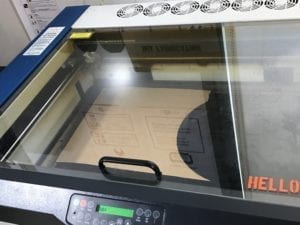
As far as material to use, we knew that we wanted him to be able to stand on his own, but we did not really know what specific material to use. When we went to work with Tristan on the laser cutter in the fabrication lab, he suggested that we could use the wood material which would be more than sufficient to allow him to stand on its own.

On a side note, because Salome and I are both very organized and motivated people, we were able to create a schedule which allowed us to reach certain benchmarks for the project well ahead of any soft or hard deadlines. This organization and getting things done early helped to prevent any last-minute-caused stress and allowed us to produce an overall successful project.
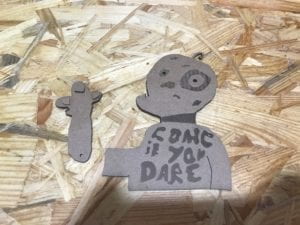
Fabrication, Production, and Assembly:
Once Hermi was born, things were able to move quickly. Salome worked on the circuits and wiring, and I created our code and put the hardware together which I think made an effective team. Before we started any of the wiring, we were able to create a simulation for our proposed circuit by using thinkercad. It was an extremely useful program and it tested our circuit for us before we created it saving us the pain of figuring out the problems through burning our figures.
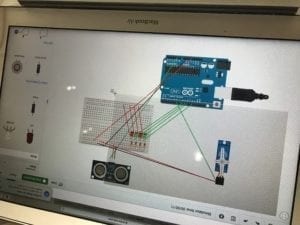
A problem we ran into the begining to put all the hardware together is that our large servo motor would not operate the same at the mini servo. With the help of Eric, we were able to discover that we had the wrong motor because it was, in-fact, a rotational servo meaning that it operated per rotation over the percentages we were aiming for our servo to move. Because we only discovered this the night before user-testing, we were unable to swap the large servos in time meaning that we used the mini servo for user testing. Our make-shift arm looked a bit ratchet I must say. It was rather disappointing to have to attach a pencil with a hand-drawn arm on it to our motor on user-testing day–especially when we had the code working for the large motor as well as our real arm, but that goes to show that it is never wise to work on things the night before in case something unforeseen happens.

User-Testing:
User testing was very successful and we got many helpful suggestions. We used the ultrasonic sensor to detect how far away people are from Hermi. For user testing, we had not actually mounted the sensor anywhere yet; as a result, we taped it to the table relatively in front of Hermi. Of course, the placement of the vital component involved in the interaction of our project is crucial, so we received some excellent suggestions about where we could place the sensor. Concerning our code, we had three main thresholds for distance inputs and resulting outputs. While we had tested them ourselves, we realized that we needed to adjust the closest output to be further away from the user because too close was . . . too close. Another pertinent suggestion we received was the request to incorporate an additional element of interaction or output from Hermi. We received a suggestion regarding creating a jaw and eyebrows so that his face would move and he could have facial expressions as well as a request to incorporate sound into his actions. Yet another comment we received concerned Hermi’s overall appearance. Is he for children and supposed to be fun? Or is he supposed to be scary? Out of all of the feedback we received, these were the common themes and the critues we attempted to adjust or build upon in our final design.
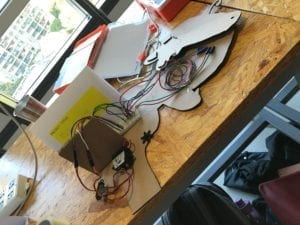
Again, because of the orderliness of our schedule, by the time we hit user-testing, I think we were able to get a helpful feedback that helped us to really enhance our project. I feel that sometimes when you are prototyping something, people cannot look past the cheap paper or cardboard materials used and get caught up on the visuals. For someone like me who is a really visual person, I think having a majority of the visual component done for user testing was really productive because it allowed us to get more practical and constructive feedback on the actual function of our project.
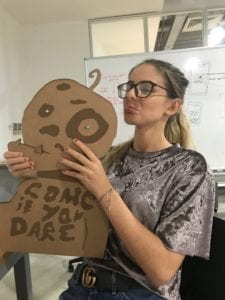
Modifications:
One of the main differences between Hermi in user-testing was his coloring. We bought some acrylic and gave him some pearly whites, greenish skin with blackish spots, and an orange shirt in the spirit of Halloween! To finish it off, we made him a bowtie that hit the sensor in a fun and in-plain-sight-kind-of way! We also made modifications to the code in order to increase the threshold in terms of what happens when a person is really close to Hermi and we got rid of the delay between the transition of each threshold which was another suggestion given to use.
I think that–at least for me– the most disappointing part of this project was our attempt to incorporate a buzzer. We were able to integrate it well enough into our circuit, as well as create code which–in theory– would yield a working sensor, but our problem seemed to be one that we could not fix. When we would try to upload our code to the board, the computer would retort that it could not find the board, port, or that there was some sort of error. Normally I feel pretty comfortable debugging my code, but after working through possible options with the code, nothing seemed to be working. In combination with some of the TA’s we postulated, what if the board was fried? In turn, we completely replaced the Ardunio and still nothing, Everything from trying a different USB cable, to new Arduino board, to redownloading the software, to using different computers, to trying to upload different codes, nothing quite seemed to work which was very bizarre.
Final Product:

Hermi was not afraid at all with everyone watching him and he performed wonderfully. I think an aspect of this project that I really loved was that the concept was not necessarily hard, but Hermi sold himself. He was cute, cartoon-like, and relatable, and I think that made people appreciate him because they felt more connected to him that just a hand or some arbitrary shaping moving back and forth. Our successful modifications from the user testing included: a paint job; eliminating the delay allowing him to change actions more smoothly and quickly depending on the distance of the user; mounting the sensor as a decorative piece on his neck; using the appropriately sized servo motor.
Conclusion:
This project was a great learning experience and also a lot of fun. We were able to successfully create a device designed to interact with children who are coming up to people’s houses to trick-or-treat. I think that Hermi’s defining characteristic was his face and his appearance which left the audience with smiles on their faces which was the overall intended purpose of Hermi. Moving forward, I would definitely work to incorporate the buzzer into his components in order to increase the numbers of ways that he can interact with the user. From this project, I gained skills in the design process of how to work with the digital fabrication machines and work with real users and incorporate their feedback. The overall purpose of our project was to create something to entertain the users under the theme of Halloween. Overall, I believe that we were able to create a project that left the audience with a smile on their face and a positive interaction with was the overall goal. The beauty of this project is that it can be used again for more seasons depending on his outfits, attire, or actions. Stay tuned for finals season; catch Hermi out in the IMA labs in a Santa hat and saying “ho, ho, ho.”